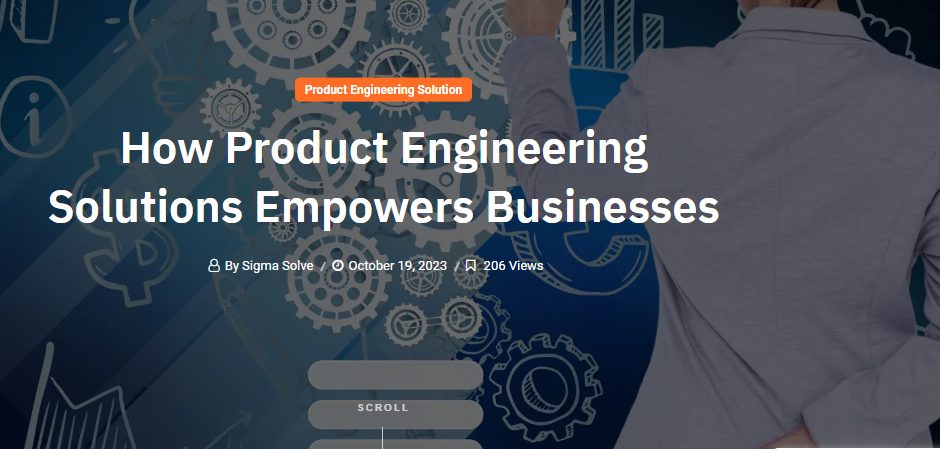Amidst these revolutionary changes fueled by digital transformation, product engineering solutions are catalytic steps toward meeting sectoral challenges.
Synopsis:
If you carefully observe global geo-economic events, you won’t be surprised to learn that almost everything is seeking or getting a makeover. Blockchain and currency digitization are set to overhaul how businesses carry out their financial transactions; artificial intelligence and automation are transforming business processes; and virtual reality is changing how we travel or entertain ourselves. Needless to say, change is the only constant here. This blog will discuss all these technologies and how they uniquely fuel business growth through product engineering.
Background:
We are all witnessing the technological evolution empowering business landscapes. Ensuring this evolution travels the last mile through enterprise solutions, product innovations, dynamic designs, and swift delivery is key to business success. Raw materials and the customer’s needs are changing along with the manufacturing processes.
Amidst these revolutionary changes fueled by digital transformation, product engineering solutions are catalytic steps toward meeting sectoral challenges. This holistic proposition encapsulates the entire product lifecycle, from conceptualization to deployment and support, utilizing emerging technology, engineering skills, and human intelligence.
What Is Product Engineering?
In simple terms, turning an idea into a full-scale practical product leveraging engineering expertise to solve a business challenge is called product engineering. Let us make it a little difficult. Product engineering involves ideation, concept creation, designing, development, deployment, maintenance, and modernization. The product may serve one or multiple industries, but it is a creation of blending technologies, engineering caliber, and human intelligence.
The global product engineering services market is valued at US$ 1200 billion and is forecasted to reach US$ 2400 billion by 2033-end at 7.2% CAGR
Product engineering deals directly with the market demands of the present and future. It leverages emerging technologies, frameworks, strategies, and methods to build specimens. Product engineers rigorously test and redesign them to achieve peak performance and a greater total experience. Consequently, not only is product quality enhanced, but it also reduces time-to-market. Moreover, such products are more sustainable and environment-friendly.
With innovative products and services, businesses will be able to survive for a long time in a highly competitive business landscape and will be able to meet consumer demands efficiently. Therefore, product engineering solutions are their fastest and easiest avenue.
The Future of Product Engineering:
Product engineering will be technology-driven, infused with insights, customized, personalized, and sustainable. The future of product engineering services is promising, as the sheer scale of innovation will drive it. Process automation, 5G connectivity, blockchain, augmented reality, virtual reality, machine learning, and artificial intelligence will ensure product development is a process to build long-lasting innovations. Product engineering services are the last resort to surf through evolving market dynamics, edging competition, and providing exceptional customer experiences. Let’s understand how product engineering solutions empower businesses and drive growth into an unassailable future.
The share of new innovative products in overall growth of product engineering will be 60% in next decade.
Streamlining Product Development:
Product development is a tumultuous process, sometimes never-ending. Therefore, businesses are inspired to utilize product engineering solutions to streamline product development processes. Product engineering ensures concurrence in the processes that are well-aligned to the objective of the product. Since product engineering involves a broad development strategy and accurate implementation, product development optimization becomes easy with futuristic technologies.
The latest tools, such as chatGPT, simulation, prototyping, or CAD software, help businesses streamline the development process from design to delivery. While one helps with ideation, another helps with rapid testing. Similarly, another can help create several design options quickly.
For example, Tesla has benefited a lot from streamlining product development. The pioneer in electric cars, Tesla, leverages computer-based design and simulation processes to quickly design and develop new cars, evaluate market dynamics, and improve the quality of old models. Tesla is an excellent reflection of product engineering solution’s capabilities in revolutionizing car manufacturing. It showcases speed, quality, a competitive edge, and greater revenue generation.
For more info: https://sigmasolve.com/how-product-engineering-solutions-empowers-businesses/


